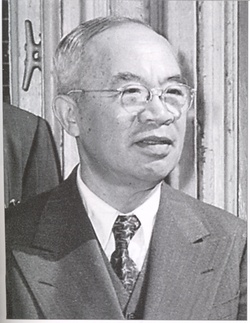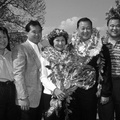On April 4, 1942, The Rafu Shimpo produced its final edition before everyone of Japanese ancestry was unconstitutionally forced to leave the West Coast by the U.S. government. No one, least of all my uncle Aki Komai, could know with any certainty if this was an interruption in the operation of the family newspaper, or its demise. A Nisei and only 32, Akira Komai was thrust into the role of publisher when the FBI came to the family house on 37th Street on December 7, 1941, and took his father, Toyosaku, away. The government incarcerated Toyosaku, without charge and without trial, for almost five years in a Department of Justice (DOJ) camp, because of his stature as publisher. Like many Issei leaders, my grandfather was isolated from his family and his community by the government. The responsibility of preserving the Japanese American newspaper fell to my Uncle Aki, the eldest son.
The challenges that Akira faced were formidable: he needed to preserve the essential component that made printing a newspaper in Japanese possible, the lead type; he needed to believe it was possible to revive the newspaper after the war; and he needed to convince others as well. To print stories in Japanese required that each character (represented by one piece of lead type) be set by hand. Because of the nature of the Japanese language, that meant thousands of characters and thousands of pieces of lead type each day. It the government had discovered the lead type, it is likely that it would have all been melted down for scrap. While the printing presses and linotype machines were important, the Japanese type was irreplaceable. Where was Uncle Aki going to get another set of Japanese lead type? Especially after the war. Japan?
Believing the newspaper could by revived, viewed almost seven decades later, might seem a given. After all, Akira and his generation were American citizens by birth. Indeed, Toyosaku made it the mission of the English section of the newspaper to promote the Americanism of the Nisei generation. But the absence of due process for the Japanese American community had to throw in doubt any future for Nikkei in the United States. It was not unreasonable to wonder if the government would ever let Japanese Americans out of camp. Yet, a dogged optimism was reflected in The Rafu Shimpo before it was swallowed up by the forced removal. In its final edition, the last English editorial had the headline, “We’ll meet again.” Part of the editorial read:
“How, then, some have asked us in recent days, can we justify the treatment of the Nisei as virtually an enemy alien Japanese? How also, others inquire, can we explain the detention of our Issei publisher whose advice and counsel were the inspiration for the steadfast program upon which our editorial policy was set? We have sincerely regretted both, but with the full conviction that time will erase the injustices of war. In the long run, the fair and the just will prevail.
“We die hard. We cease publication today in the full faith and belief that we shall go forward to publish once again—and soon.”
Most of the Komai family wound up in the Amache1, Colorado concentration camp in 1942. While Toyosaku was being moved around the country to places like Missoula, Montana; Fort Sill, Oklahoma; and Camp Livingston, Louisiana, Akira hunkered down in Amache and began writing letters to former Rafu Shimpo employees (when he could locate them) to keep the idea of the revival of the newspaper in their minds. An example of this correspondence was produced by former pressman Roy Matsumura, who had a copy of a letter from Akira written in 1943. Roy told me that my uncle kept in contact with as many employees as possible in a similar fashion.
In 1945, Akira was able to return to Los Angeles. To his relief, he discovered the precious Japanese type still intact. He had hidden them in sacks, placed in the old Rafu building, which they were able to maintain during the war. But, he still lacked two other essential ingredients to revive the newspaper: workers and money. In a letter to his father written on October 5, 1945, Akira observed, “About the capital for Rafu Shimpo, I am very discouraged. I ask every other person that I meet for financial assistance. Mr. Akie Yasuda is in town and I have sought his help, and while he is helpful he has not been able to help. In other words, I am discouraged. Perhaps, I shouldn’t be, but I am.”
In his reply on October 17, 1945, Toyosaku wrote, “You should not depend (upon) my returning for the reestablishment of the Rafu Shimpo. At the same time do not hurry reopening. When the time (is) ripe, the community will demand (it).”
In the end, three former employees, Shinaichi Tambara, Itaro Nagai, and Katsujiro Obana pooled their money to help buy newsprint (which was scarce at the time) and other essentials, and a date was set to begin printing the newspaper again: January 1, 1946. Success was hardly assured as Akira wrote to his father: “our only hope is that there will be sufficient newsprint and enough workers by that time (of the first edition).” Other former employees such as Henry Mori, Jiro Tani, Roy Matsumura, Paul Uyemura, and Teiho Hashida returned to Los Angeles and without a guarantee of a paycheck, went back to work.
Toyosaku, who would not be released until later in 1946, was able to see the first edition of the revived Rafu Shimo while incarcerated in a government-run camp in Santa Fe, New Mexico. Akira wrote his father, “I’m very glad that you liked our first edition of The Rafu Shimpo. We decided to publish right after my return from Santa Fe. The composition of the newspaper took much more time than we had anticipated. We do not have enough workers in the koba and it is a task to put out the newspaper every day, but we manage somehow.”
It was a task he would manage for more than three decades (including paying back the loan from the employees). Toyosaku was finally released by the government but lived only another four years. Ironically, my cousin Michael took over for his father when Uncle Aki died in 1983. Mickey was 31 at the time, similar to when his father took over from his father. Like his dad, Mickey relied on many of the long-time employees of The Rafu Shimpo to get through his early years as publisher. It explains why a family business that began at the beginning of one century has lasted through the beginning of the next.
Notes:
1. Amache—Granada is the correct official name for Amache, although former inmates still call it Amache. Other official camp names are Central Utah for Topaz and Colorado River for Poston (Arizona).
* This article was originally published in Nanka Nikkei Voices: The Japanese American Family (Volume IV) in 2010. It may not be reprinted or copied or quoted without permission from the Japanese American Historical Society of Southern California.
© 2010 Japanese American Historical Society of Southern California








